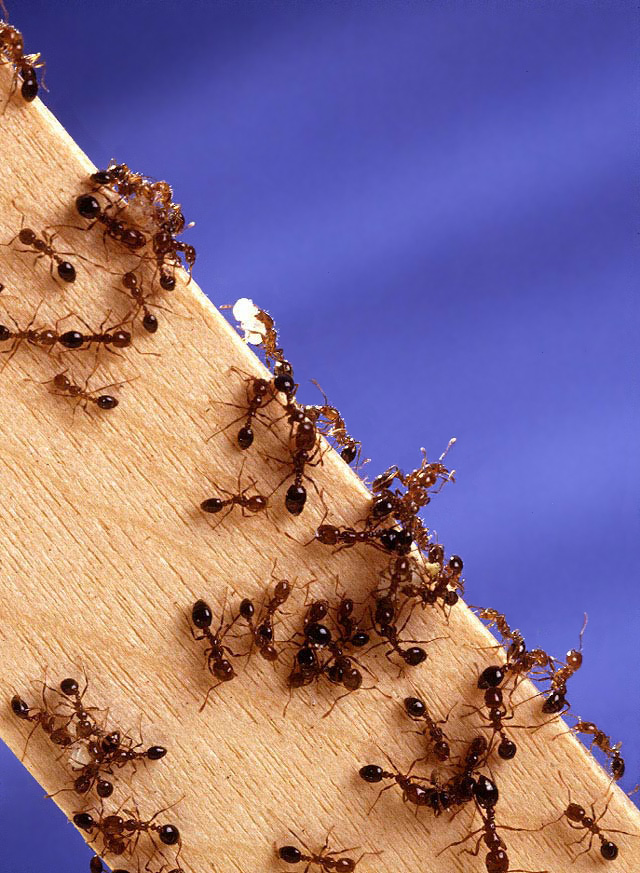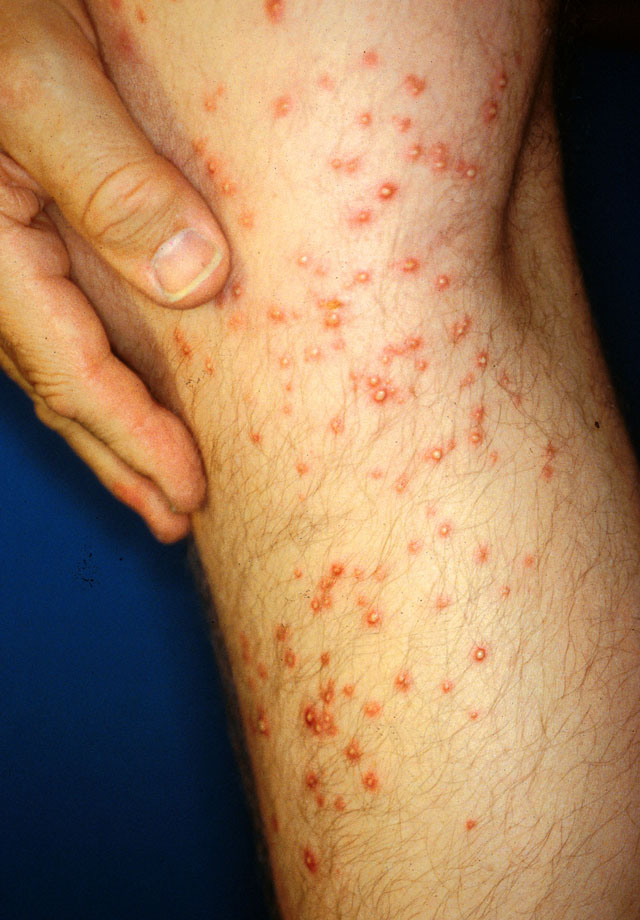Continuing Education Activity
Fire ants tend to be an aggressive insect that will sting causing very painful reactions. There are two types of fire ants which belong to the Solenopsis species. The first is a red, imported fire ant, Solenopsis invicta and the second is the black imported fire ant, Solenopsis richteri. This activity reviews the pathophysiology of fire ant bites and highlights the role of the interprofessional team in its management.
Objectives:
- Describe the pathophysiology of fire ant bites.
- Review the presentation of a fire ant bite.
- Summarize the treatment options for fire ant bites.
- Outline the importance of improving care coordination among interprofessional team members to improve outcomes for patients affected by fire ant bites.
Introduction
Fire ants tend to be an aggressive insect that will sting causing very painful reactions. There are two types of fire ants which belong to the Solenopsis species. The first is a red, imported fire ant, Solenopsis invicta and the second is the black imported fire ant, Solenopsis richteri. They were introduced into the United States at Mobile, Alabama about 40 years ago. Red fire ants are predominately seen in 14 states: Alabama, Arkansas, California, Florida, Georgia, Louisiana, Mississippi, New Mexico, North Carolina, Oklahoma, South Carolina, Tennessee, Texas, and Virginia. Worldwide locations include the Caribbean islands, Puerto Rico, the Bahamas, the British and United States Virgin Islands, Antigua, and Trinidad, Australia, New Zealand, Taiwan, and China.
The black fire ant is seen only in northern Alabama, northern Mississippi, and southern Tennessee.
Over the next decade, the fire and Solenopsis invicta is expected to spread to California and towards the Pacific coast nearing the Canadian border.
Fire ants do not need to be provoked to attack, and their venom is capable of causing a painful local reaction and, in some instances, result in life-threatening anaphylaxis. [1][2][3]
Etiology
Ant bites usually occur when their nest is disturbed. They will swarm and sting any living human or animal with which they come in contact. One ant is capable of multiple stings within a very short time frame. Bites can occur year-round but are most common in the summer months. [4][5][6]
Epidemiology
Ant bites occur most commonly in children, usually on the lower extremities. Patients who are less mobile are also at risk because they are less aware of their environment and often are not able to move away from the ants. Ants do not discriminate between age or sex and will attack any living animal.[7]
Pathophysiology
When the ant stings, it does so with its mandible, which locks onto its prey. It arches its body and then injects venom through the stinger located on the abdomen. As it stings, it does so at an average of 7-8 stings. It rotates its body which results in a circular pattern resulting in pain and itching at the site. The venom of the fire ants is used to immobilize or kill prey for food yet has also demonstrated insecticidal, bactericidal, and fungicidal activity. The venom is 95% water-insoluble alkaloid, with the remaining 5% being an aqueous protein solution. It is the alkaloid part of the venom that causes a sterile pustule at the sting site and has cytotoxic and hemolytic properties. The protein portion contains the allergens. The reactions range from immediate localized wheal and flare responses to large, local or systemic reactions which can include anaphylaxis.
The immediate reaction to the venom is an intense burning sensation which explains the common name of the ants. When the sensation subsides after a few minutes, a dermal flare and wheal occur and papules form within two hours. Vesicles develop within four hours and by 24 hours these develop into sterile pustules. A pustule forms as a result of the venom alkaloids, but it is not allergenic.
Another response is the large local reaction, which is characterized by a reaction larger than 10 cm in diameter and associated with localized erythema and edema. They are very painful and pruritic, lasting 24 to 72 hours.
The local reactions of the fire ant sting can cause anaphylaxis, which is a response to the aqueous protein solution. Anaphylaxis usually occurs in those sensitized by a previous sting. These symptoms include flushing, generalized urticaria, angioedema, laryngeal edema, bronchospasm, or loss of consciousness.
Fire ant stings also are capable of causing serum sickness, nephrotic syndrome, seizures, worsening of pre-existing cardiopulmonary disease, and anaphylaxis.
Histopathology
The local reactions are IgE-mediated, with the resulting lesion comprised of a dense fibrin gel along with eosinophils, neutrophils, and lymphocytes. Cutaneous systemic allergic reactions include urticaria, angioedema, pruritus, and erythema as well as severe, life-threatening bronchospasm or laryngeal edema. One sting can cause anaphylaxis. The identifying hallmark of fire ant envenomation is the pustules that form after the sting.
History and Physical
The most common scenario is one where the patient is outside, in the yard or the woods, and is standing on or near an ant nest. Disrupting the nest causes a large number of ants to swarm and attack. However, the imported fire ant can attack with little warning. The ants will swarm and repeatedly sting the lower body. The most common reaction is a wheal and flare, which is a lesion that has resembles a hive but also is surrounded by erythema. The stings are very painful and cause intense itching. A second lesion that can result is a sterile pustule that develops within the first 24 hours and is filled with yellow fluid. They are sterile and are the result of the venom alkaloids lasting for about one week. A large, local reaction, typically over 10cm in diameter, may occur which has a pustule on top of a painful inflamed and swollen area. Lastly, anaphylaxis is possible. However, these reactions typically occur in those who have been stung by an ant or a yellow jacket once before as its venom is known to cross-react with the Solenopsis venom in vitro.
Evaluation
Diagnosis of ant-induced hypersensitivity can be performed by a patient history of allergic reaction to stings, by physical examination, or through the use of in vivo or in-vitro tests. Useful clinical clues to aid in the diagnosis of a fire ant bite include the development of a typical pustule at the sting site after 24 hours. Identification of the ant is helpful in the diagnosis. The most specific diagnosis comes from the clinical manifestations of fire ant sting reactions with IgE detection by skin testing.
Treatment / Management
Most ant bites require supportive care, so treatment is aimed at preventing secondary bacterial infections if a pustule is disrupted. The use of topical hydrocortisone or antihistamine cream is usually all that is needed. The sterile pustules should be left alone, however, if they are broken then they need to be cleaned with soap and water and an antibiotic cream placed on top. If the broken lesion gets infected, then a proper antimicrobial can be used. Those with large local reactions will benefit from a single dose of 20 mg prednisone. Localized pain and swelling may be improved with cold compresses. Anaphylactic reactions are treated the same as any other anaphylaxis, using epinephrine first followed by steroids, antihistamine, and H2 blocker. Fluid resuscitation and oxygen therapy should be included as part of supportive treatments.[8][9]
Differential Diagnosis
One must be aware of other potential insects that sting, such as a yellow jacket or bee. Most local reactions have erythema, so differentiating this from cellulitis is important. Patients who have had hypotension with stings should be evaluated for mast cell disorders and have a baseline tryptase level ordered.
Prognosis
The prognosis is very good for patients presenting with ant bites as most bites are managed conservatively not requiring extensive care. Patients who seek medical care demonstrate serious systemic allergic reactions which occur in about 2% of fire ant stings. One study reported 83 deaths out of 29,300 patients. Infants and the elderly were the most at risk.
Pearls and Other Issues
First Aid
Rub off ants briskly, as they are able to attach to your skin and sting multiple times. Antihistamines and corticosteroid creams may help. If you develop severe chest pain, nausea, sweating, shortness of breath, severe swelling or slurred speech, seek immediate medical attention.
Avoidance
Do not disturb ant mounds. Be cautious when lifting any items off the ground as ants may be underneath. Tuck pants into socks or boots. A person with a known, severe allergy to insect bites or stings should carry an epinephrine auto-injector and wear medical identification jewelry listing the allergy.
Enhancing Healthcare Team Outcomes
Fire ant bites are not uncommon in souther USA. Since most patients present to the emergency room following a fire ant bite, the triage nurse must know the signs and symptoms of the disorder. Because the fire ant bite can be associated with a serious allergic response, timely admission and treatment is mandatory. for the most part, the bite of a fire ant is managed with supportive care, but sometimes one may need to an antihistamine and an NSAID to decrease the itching and pain. Personnel in the emergency room must be familiar with the use of epinephrine in case a patient has an anaphylactic shock. A person with a known, severe allergy to insect bites or stings should carry an epinephrine auto-injector and wear medical identification jewelry listing the allergy.


